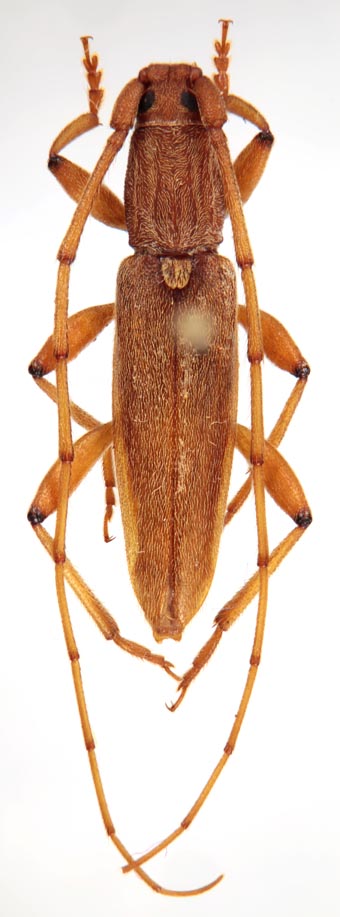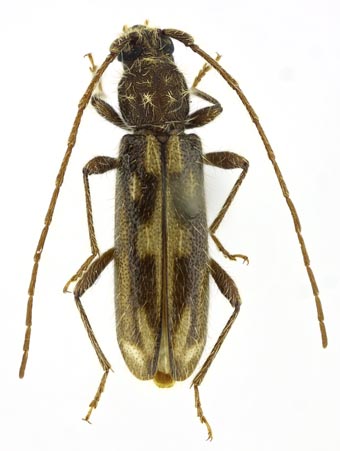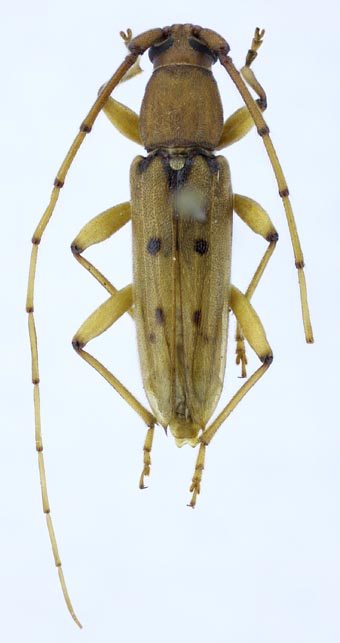 |
Achrysonini
Classification
Introduction
- The tribe Achrysonini Lacordaire, 1868 currently contains 64 species in 20 genera. Photographs of 3 exemplar specimens are currently available for this tribe.
Diagnostic Features of Adults
- Body size variable, from small (less than 10 mm) to large (more than 40 mm); generally elongate. Eyes generally reniform, complete (not completely divided into upper and lower lobes). Antennae generally filiform, unarmed, rarely serrate, flabellate, or expanded laterally; antennae 11-segmented, long, extending beyond tip of abdomen. Pronotum variable, from generally elongate (distinctly longer than wide) to approximately subquadrate (about as long as wide); lateral margins of pronotum unarmed, without distinct spines or tubercles. Mesocoxal cavities closed to mesepimeron. Elytral apices variable, with or without distinct spines.
Diagnostic Features of Larvae
- Mature larva. Length up to 23 mm; maximum breadth (at prothorax) 5.5 mm. Form subcylindrical, slightly tapering. Head with sides diverging posteriorly; genae smooth, pale, sparsely setose. Mouthframe ferruginous and completely sclerotized beneath antennae. Antenna with third segment at least three times as long as basal width and about half length of second: supplementary process short, about one-fourth length of third segment. Mandible pitchy, with a shallow fovea which is sometimes longitudinally produced. Labrum roundly trapezoidal, bearing short setae. One pair of ocelli present, contiguous with base of antennae: lens very strongly protuberant; pigmented spot indistinct. Hypostoma transversely rugose, with front margin narrowly ferruginous ; sutures distinct, almost straight; gula narrow, with sutures protuberant. Maxilla with third segment of maxillary palpi as long as second; process of palpifer distinct but very short. Prothorax trapezoidal, with lateral regions bearing fine, slender setae. Pronotum strongly and regularly punctate anteriorly; finely reticulate and irregularly, longitudinally striate posteriorly; median cleavage line distinct. Mesonotum and metanotum finely granulate. Prosternum bisected by a strongly raised, longitudinal ridge. Abdomen with dorsal ampullae shining, finely reticulate and with two pairs of lateral impressions. Ninth tergite with a pair of paramedian, oval, testaceous, carinae or tubercles which are rather faint in some specimens. Pleural discs granulate and distinct on first three abdominal segments. Legs four-segmented, testaceous, about as long as maxillary palpi. Spiracles small, broadly oval, with peritreme thin and pale. Adapted from Duffy (1953).
Geographic Distribution of Tribe
Biology and Economic Importance
- Biology unknown for most members of this tribe. Species of this tribe are potentially invasive outside their native range.
Selected References to Adult Specimens
Selected References to Larvae Specimens
|  |

Achryson immaculipenne
Gounelle, 1909; dorsal
♂ specimen
Cerambycidae:Cerambycinae:Achrysonini
Photograph © G.D. Ouellette

Achryson maculipenne
(Lacordaire, 1863); dorsal
♀ specimen
Cerambycidae:Cerambycinae:Achrysonini
Photograph © A.M. Hodson

Achryson surinamum
(Linnaeus, 1767); dorsal
♂ specimen
Cerambycidae:Cerambycinae:Achrysonini
Photograph © A.M. Hodson
|




